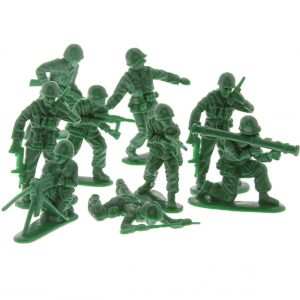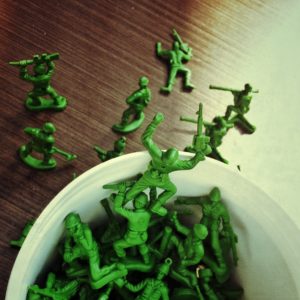 Our parents loved it when we asked for inexpensive toys. I guess that’s because we so seldom did so. While TV commercials hawked expensive games and toys, the subject of today’s piece was, and continues to be, a huge seller with no advertising whatsoever.
Our parents loved it when we asked for inexpensive toys. I guess that’s because we so seldom did so. While TV commercials hawked expensive games and toys, the subject of today’s piece was, and continues to be, a huge seller with no advertising whatsoever.
Plastic green army men were in residence by the dozens in practically every toybox in America in the 1960’s. After all, they were available at the dime store, individually for a nickel, or in a bag of 50 or so for 99 cents. And while it took some serious cajoling to get mom to spring for a toy like the James Bond attache case, she could sometimes be convinced to throw a bag of army men into the basket, or at the very least allow me a dime to get a couple more of the guys shooting the rifle while laying prone on the ground (I loved those!).
What would happen next would generally involve going to a friend’s house, or having one come over to yours. Both parties would have their own armies. There was no need to mark which ones belonged to each opposing sides, because hand-to-hand fighting generally didn’t take place.
The battle would begin with strategic planning. The battleground, generally an area of the home team’s bedroom, would be scanned out by both generals. Then, the platoons would be emplaced so as to inflict the most damage on the enemy. After the soldiers were in position, the battle would begin.
The first shot would be fired. This, in my case, would consist of one of my prone riflemen opening fire on an opposing infantryman. The reports of his machine gun fire would be provided courtesy of my sound effects, perfected by many hours of watching Rat Patrol and learning to imitate their jeep-mounted 50 cal. The hapless first victim would be proclaimed to be dispatched by me, as I turned him over on his back to symbolize his departure. I might throw in an “aaargh!” for further effect.
Then, it was the rival general’s turn. One of my own would bite the dust.
 We liked close battles, so even if one of us had a smaller army, the odds were evened by allowing things like bombers to take out several of the enemy at once. Of course, the bomber would immediately be shot down afterwards. After all, this battle belonged to the army men, not technology.
We liked close battles, so even if one of us had a smaller army, the odds were evened by allowing things like bombers to take out several of the enemy at once. Of course, the bomber would immediately be shot down afterwards. After all, this battle belonged to the army men, not technology.
The skirmish would continue until it was down to two individuals. They would then blow each other away. In play, as in real life, war has no winners, only losers.
The army men were frozen in different battlefield poses, including the bazooka guy on one knee, the hand grenade thrower at full backswing, the guy talking on the radio, and several soldiers caught in the act of shooting rifles.
Like real soldiers, we generals considered the inexpensive army men to be expendable. I can remember blowing them up with firecrackers, launching them into space tied to a three bottle rockets at once, and melting them with a magnifying glass. The local ants preferred that I target the army men, as well.
I also remember turning them into paratroopers by tying a handkerchief to them with sewing thread, carefully rolling it into a parachute, then tossing it as high into the sky as I could. The chute usually opened, although it was still fun when it didn’t, as I could accompany the unfortunate jumper with a death scream all the way to the ground.
Marx began manufacturing green army men in the early 50’s. While the Vietnam War was going on as we played in the 60’s, we never imitated its battles. World War II was fun. It was over. We won. But mention of the Vietnam War incited images of wailing neighborhood parents having been informed of the death of their son.
That wasn’t fun at all.